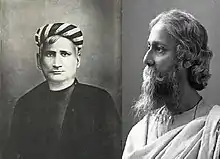Bengali poetry
Bengali poetry is a rich tradition of poetry in the Bengali language and has many different forms. Originating in the Bengal region of South Asia, the history of Bengali poetry underwent three successive stages of development: poetry of the early age (like Charyapad), the Medieval period and the age of modern poetry which was introduced in the 1930s. The national poet of Bangladesh, the country with the highest number of native Bengali speakers, is Kazi Nazrul Islam - a 20th-century writer infamous for his activism against British colonial rule through revolutionary works such as Bidrohi (Rebel).
| Bengali literature বাংলা সাহিত্য | |
|---|---|
 | |
| Bengali literature | |
| By category Bengali language | |
| Bengali language authors | |
| Chronological list – Alphabetic List | |
| Bengali writers | |
| Writers – Novelists – Poets | |
| Forms | |
| Novel – Poetry – Science Fiction | |
| Institutions and awards | |
| Literary Institutions Literary Prizes | |
| Related Portals Literature Portal India Portal | |
History

Poetry in the colloquial dialect of Bengal first originated from Prakrit, and based upon local socio-cultural traditions. It was antagonistic towards Vedic rituals and laws as opposed to the sahajaya traditions of the poets themselves - who were mainly Buddhist sages.[1]
The medieval period marked the introduction of puthis, which played an important role in Muslim life and brought much Persian and Arabic influence to the poetic lexicon. Shah Gharibullah was said to have initiated this puthi trend with his epic "Amir Hamza". Many jongonamas, puthis based on battles, were written during this time. Jongonamas were generally elegiac in tone. Works relating to Karbala were called marsiya (meaning 'grief' in Arabic) literature. Both janganama and marsiya literature first developed in Arabia and later Persia. Muslim Sufis and soldiers introduced this form of poetry in the Bengali language to the masses in Bengal and Arakan. Well-known poems of include Zainab's Chautisha by Sheikh Faizullah, Maqtul Husayn by Mohammad Khan and Qasim-er Lodai O Fatima-r Surotnama by Sherbaz. The works mixed Bengali folk poetry with Perso-Arabian stories and themes, and are considered an important part of the Muslim culture of Bengal.[2]
Following the Partition of India in 1947, Bengali poets were divided along nationalistic lines of India and Pakistan. The poets of East Bengal celebrated the glory of Islam, many taking inspiration from Kazi Nazrul Islam. Some of the popular Bengali Muslim poets of this period included Farrukh Ahmad, Talim Hossain, Golam Mostofa and Raushan Yazdani. The Bangladesh Liberation War and struggle for freedom became a popular theme in the years that followed. Al Mahmud is considered one of the greatest Bengali poets to have emerged in the 20th century.[3]
References
- Arif, Hakim (2012). "Poetry". In Islam, Sirajul; Miah, Sajahan; Khanam, Mahfuza; Ahmed, Sabbir (eds.). Banglapedia: the National Encyclopedia of Bangladesh (Online ed.). Dhaka, Bangladesh: Banglapedia Trust, Asiatic Society of Bangladesh. ISBN 984-32-0576-6. OCLC 52727562. Retrieved 1 February 2021.
- Khandker Muzammil Haq (2012). "Janganama". In Islam, Sirajul; Miah, Sajahan; Khanam, Mahfuza; Ahmed, Sabbir (eds.). Banglapedia: the National Encyclopedia of Bangladesh (Online ed.). Dhaka, Bangladesh: Banglapedia Trust, Asiatic Society of Bangladesh. ISBN 984-32-0576-6. OCLC 52727562. Retrieved 1 February 2021.
- "Al Mahmud turns 75". The Daily Star. 13 July 2011. Retrieved 15 February 2019.